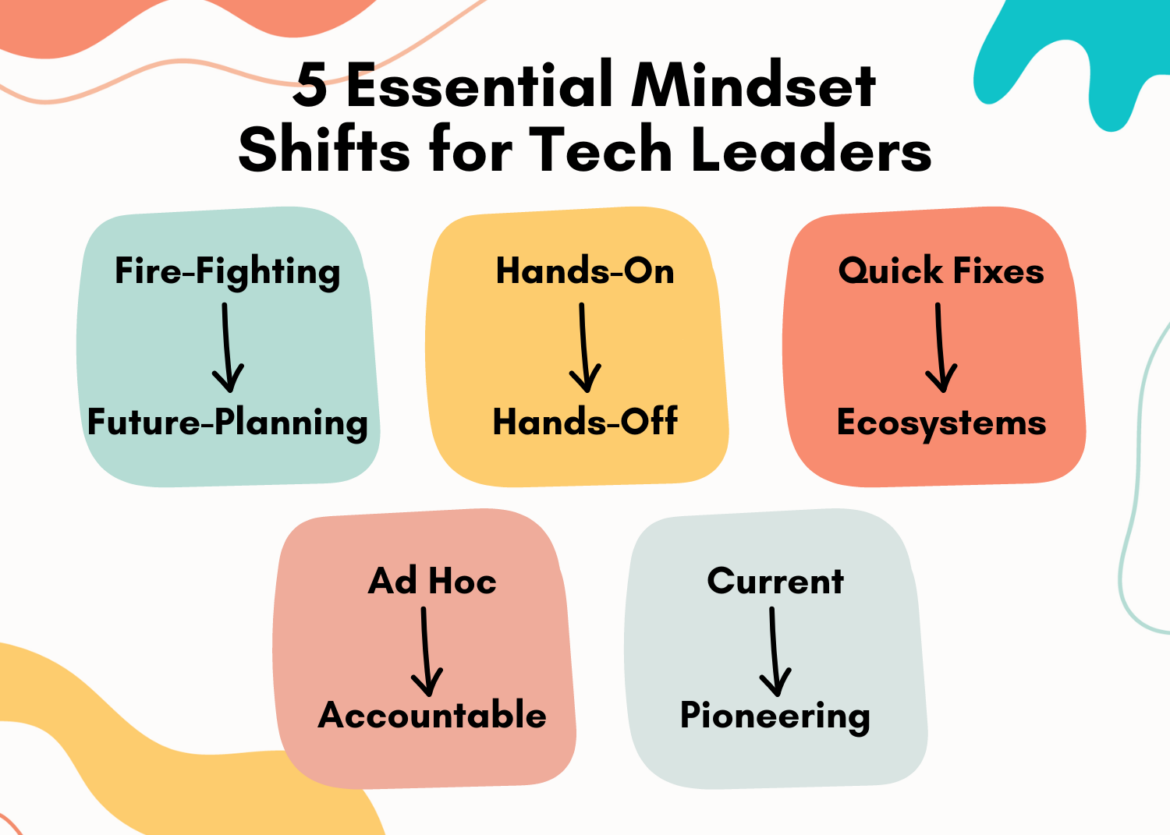Leading any team or organization can definitely be a challenging task, regardless of your position within the hierarchy. The responsibilities that come with being a director of a department or a CEO can often feel overwhelming, especially when navigating the complexities of decision-making, resource management, and team dynamics. However, with the right approach and mindset, you can effectively manage and even mitigate some of these stressors, operating more efficiently and leading more effectively. Let’s look at five different mindsets to consider shifting to this year.
1. From Fire-Fighting to Future-Planning
Peter Drucker says, “The best way to predict the future is to create it.” That is what the new Future-Planning mindset is all about. Fire-fighting in a technology leadership context often involves reacting to immediate problems as they arise. This can mean constant troubleshooting, dealing with daily tech crises, or addressing user complaints without a moment to pause. It’s a reactive mode where strategic planning takes a backseat to urgent tasks that demand instant attention. However, the future-planning mindset is about proactively setting a course for the future of technology within the school district. It involves understanding long-term educational goals and aligning technology initiatives to support these objectives. This strategic approach helps anticipate needs, mitigate risks before they become issues, and ensure that the technology infrastructure is robust and scalable to meet future demands.
In order to make the shift, consider these three steps:
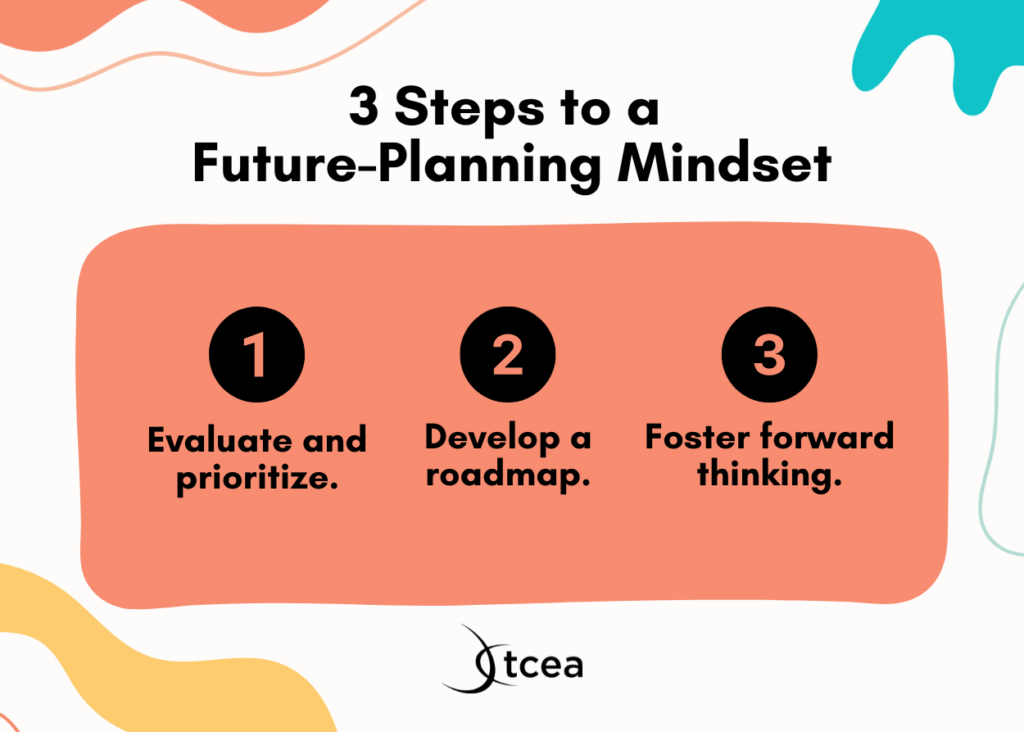
- Evaluate and Prioritize: Take stock of the current technological challenges and distinguish which are merely urgent from those that are important. Prioritize initiatives that align with long-term educational goals.
- Develop a Roadmap: Craft a strategic technology roadmap that outlines progress milestones. This roadmap should dovetail with the district’s educational objectives and include input from a wide range of stakeholders.
- Foster Forward Thinking: Instill a culture of anticipatory and strategic thinking within your team. Encourage and support training that focuses on future trends and strategic implications of today’s tech decisions.
As you work to make this mindset shift, set aside dedicated time each week to focus solely on strategic planning. This time should be uninterrupted and treated as a critical part of your role. It’s the space where you can think deeply about the ‘big picture’ and how each step you take is building towards it.
2. From Hands-On to Hands-Off
The hands-on approach typically involves a leader who is deeply involved in the day-to-day operational tasks, often taking on technical problems directly. This can include personally managing IT projects, troubleshooting, and getting involved in the details of technology management, which leaves little room for broader leadership responsibilities. Embracing a hands-off approach allows a leader to step back and focus on strategic leadership, which can lead to better resource allocation, more effective team development, and the ability to guide larger, district-wide technology initiatives. It emphasizes the importance of empowering team members to take ownership of tasks and make decisions, fostering a sense of responsibility and professional growth.
Because this shift may be a struggle for many, keep in mind these three steps that are critical to a successful transformation:
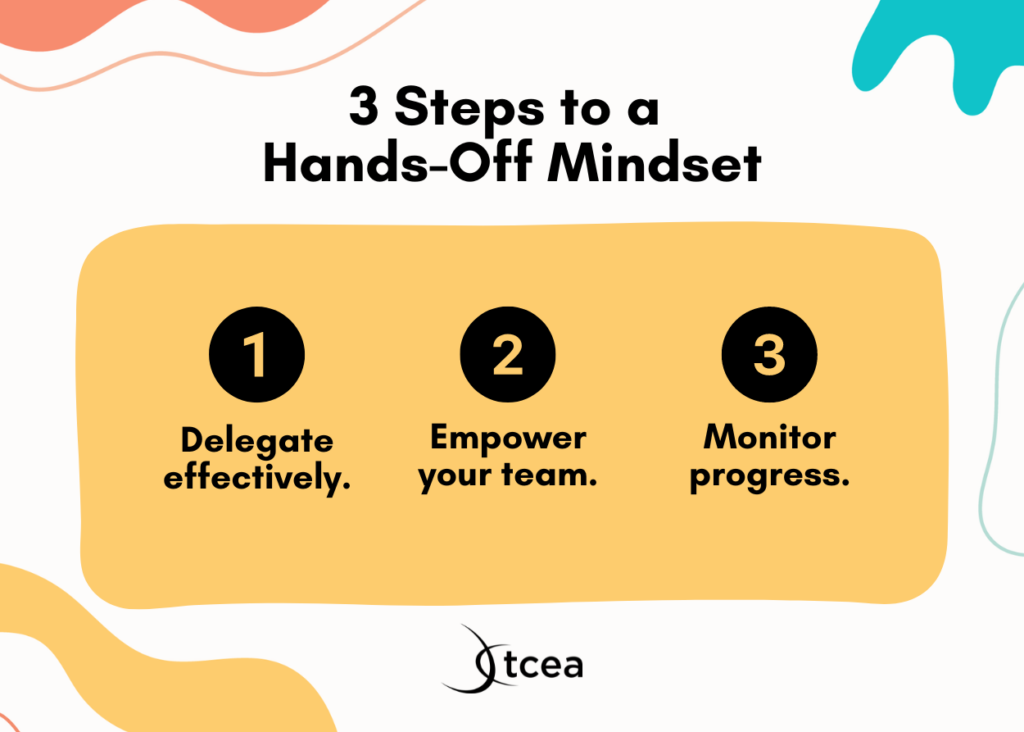
- Delegate Effectively: Identify tasks that can be delegated to team members with the right skills and experience. Clearly communicate expectations and provide the necessary resources for them to succeed.
- Empower Your Team: Build confidence in your team by providing opportunities for decision-making and problem-solving. Encourage autonomy while maintaining support and guidance when needed.
- Monitor Progress: Keep track of delegated tasks and projects with regular check-ins, rather than constant oversight. This ensures accountability without micromanagement.
Steve Jobs captured the essence of this mindset shift when he said, “It doesn’t make sense to hire smart people and then tell them what to do; we hire smart people so they can tell us what to do.” Learn to rely on the collective intelligence and expertise of your team. And, as you can imagine, trust is key in a hands-off approach. Build trust with your team by demonstrating confidence in their abilities and being open to their methods of problem-solving, which may differ from your own.
3. From Quick Fixes to Creating Ecosystems
If you have a quick fix mindset, then you might find that you focus on temporary solutions to immediate problems, often without addressing the underlying issues. In a technology context, this might involve patching software, hastily implementing new tools without full integration into existing systems, or repeatedly solving the same problems without long-term improvement. The shift towards creating ecosystems involves developing and implementing comprehensive, integrated systems that address the root causes of issues and support the broader educational goals. It’s about seeing the technology landscape as a holistic entity, where each part works seamlessly with the others, enhancing efficiency, scalability, and user experience.
Quick fixers may find it difficult to slow down and focus on the bigger picture so think about following these three steps to help ease the pain of change:

- Analyze Systemically: Look beyond the surface to understand the interconnectedness of your technology systems. Identify how changes or additions affect the ecosystem as a whole.
- Plan Holistically: Design technology solutions with the big picture in mind. Ensure that new tools or processes are fully integrated into your existing infrastructure, supporting and enhancing the overall ecosystem.
- Implement Sustainably: Roll out new systems or updates in a way that ensures long-term sustainability. This includes thorough testing, training for users, and ongoing support to maintain and improve the system over time.
As you work on creating more integrated systems, ensure that your ecosystem can evolve with new technologies and educational needs without requiring a complete overhaul. Bill Gates sums this up well with his insight related to the quick fix mindset when he said, “The first rule of any technology used in a business is that automation applied to an efficient operation will magnify the efficiency. The second is that automation applied to an inefficient operation will magnify the inefficiency.” Let this be the year that you transition to a mindset that magnifies efficient ecosystems that produce long-term results.
4. From Ad Hoc to Accountable
This approach is characterized by making decisions or solving problems through improvised solutions without a consistent plan or policy in place. In technology leadership, this might manifest as sporadic technology updates, inconsistent implementation of software across departments, or reactive policies that change frequently without clear direction. This may be the default mindset because you are understaffed, overworked, and overwhelmed trying to keep things together. Shifting to an accountable mindset means establishing clear, consistent policies and procedures for technology use and management within the school district. It involves creating a structured framework that governs decision-making, ensures compliance with regulations, and aligns with educational objectives. This approach enhances transparency, reliability, and trust among all stakeholders.
This mindset shift doesn’t happen overnight so give yourself time as you move through these steps to establish an accountable mindset that will serve you well:
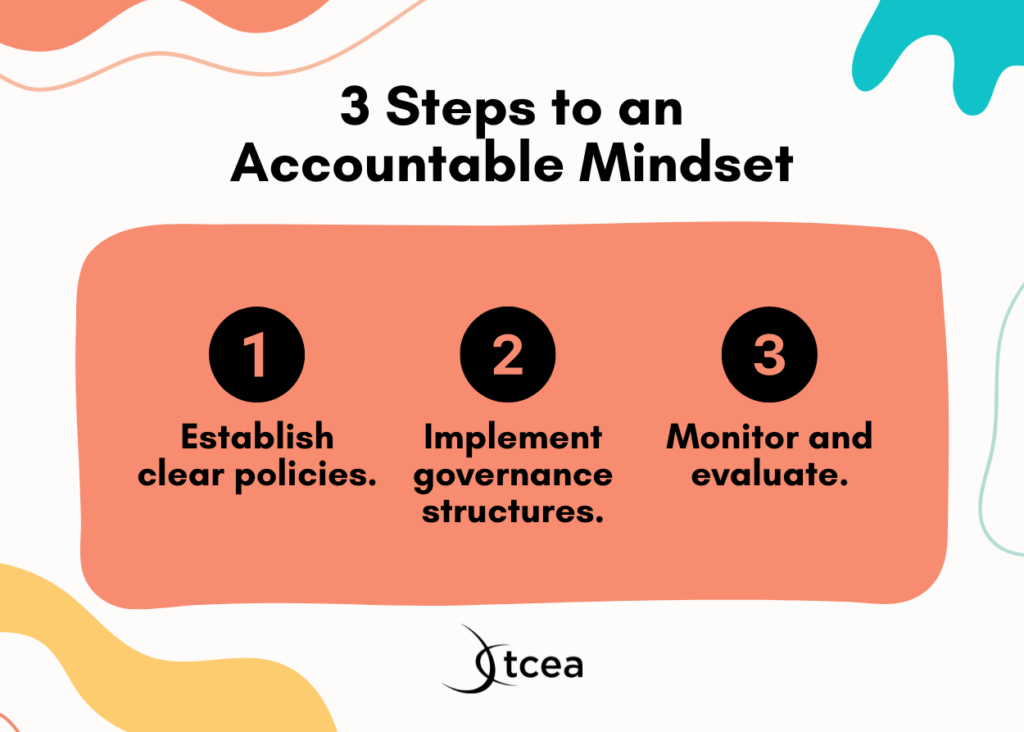
- Establish Clear Policies: Develop comprehensive technology policies that address usage, security, privacy, and ethics. Ensure these policies are well-documented and accessible to all stakeholders.
- Implement Governance Structures: Set up governance bodies or committees that include representatives from various stakeholder groups. These bodies should oversee technology decisions, ensuring they align with policies and the district’s educational goals.
- Monitor and Evaluate: Regularly review and assess the effectiveness of technology policies and governance structures. Be open to feedback and willing to make adjustments to respond to new challenges or opportunities.
Consistency is key in transitioning to an accountable approach. Ensure that all decisions and policies are consistently applied across the district, which builds a foundation of trust and reliability in your technology leadership. Rosalynn Carter, former First Lady of the United States, offered a powerful perspective on leadership saying, “A leader takes people where they want to go. A great leader takes people where they don’t necessarily want to go, but ought to be.” Through your consistent work on developing an accountable mindset, you will help take your staff and district where they ought to be.
5. From Current Operations to Pioneering Innovation
Focusing on current operations involves managing and maintaining the current technological infrastructure and processes. It’s about ensuring that the day-to-day technology needs of the school district are met, which is crucial but can become a limiting perspective if it’s the sole focus. Shifting towards pioneering innovation means looking beyond the immediate and existing technological landscape to explore and implement new technologies and approaches that can transform educational experiences. It’s about embracing change, being forward-thinking, and seeking opportunities to leverage technology in ways that enhance learning, teaching, and administration. Though we might enjoy predictability and knowing what to expect, adopting this mindset can free us to help our district realize more potential.
For this mindset, you will want to have folks around you who can offer insights from their perspectives. By doing so and following these steps, you can be that pioneering innovator:
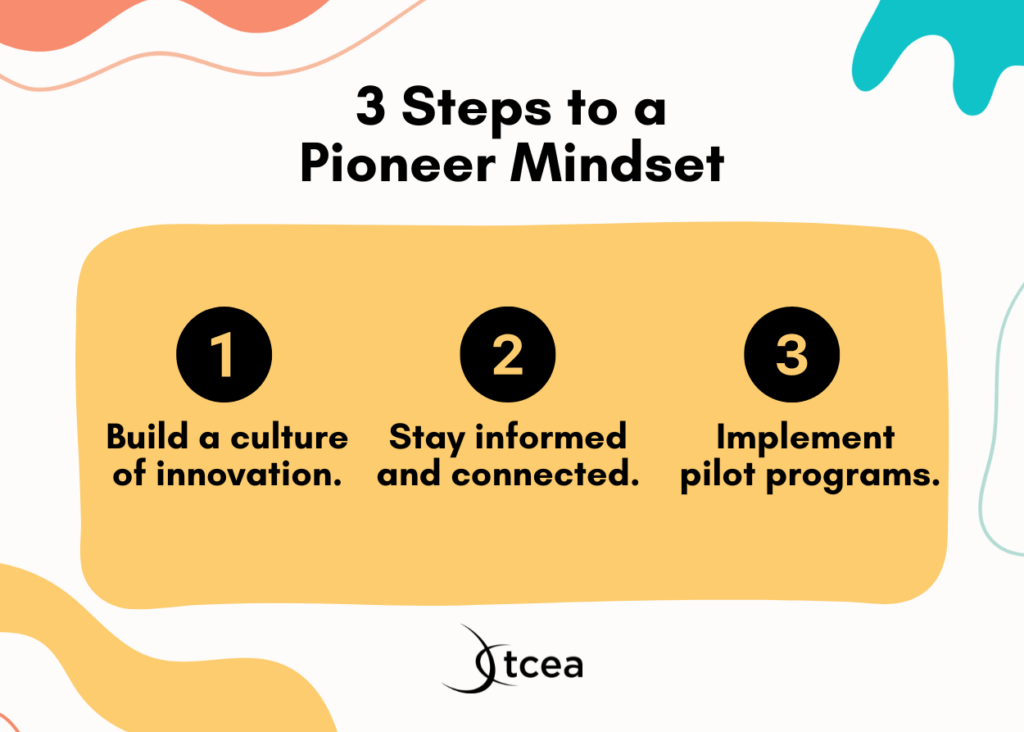
- Cultivate a Culture of Innovation: Encourage experimentation and the exploration of new ideas within your team. Celebrate creative thinking and the willingness to try new approaches, even if they don’t always succeed.
- Stay Informed and Connected: Keep abreast of the latest trends in educational technology by attending conferences, participating in professional networks, and reading industry literature. Bringing fresh ideas into the district is easier when you know what’s out there.
- Implement Pilot Programs: Test out new technologies or teaching methods on a small scale before rolling them out district-wide. Pilot programs can provide valuable insights into what works and what doesn’t, allowing for adjustments before significant resources are committed.
William Pollard, a physicist, priest, and member of the Manhattan Project, remarked, “Without change, there is no innovation, creativity, or incentive for improvement.” Those who initiate change will have a better opportunity to manage the change that is inevitable. Learn to have this mindset so that you can be a part of managing the very change that needs to take place to take your students to the next level. Innovation is rarely a quick or linear process. It requires time, experimentation, and sometimes, a tolerance for failure. The key is to learn from each experience and to keep pushing forward. Be patient and persistent.
What mindset will you adopt?
As technology leaders in the dynamic realm of education, it’s essential to pause and reflect on our current approaches to leadership and management. Each of these five mindsets presents a unique lens through which to examine our practices. Consider which of these shifts resonates most with your current situation. Which aspects of your leadership style might be rooted in reactive, short-term thinking? How could embracing a more strategic, forward-looking approach benefit your team, your students, and the broader educational community? Making the commitment to shift your mindset is the first step toward transformative leadership that not only addresses today’s challenges but also anticipates and innovates for the future of education.
And, if you need to connect with others in the process as you consider the transition, be sure to take advantage of the TCEA Community group just for CTOs and Technology Directors.

